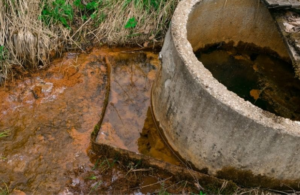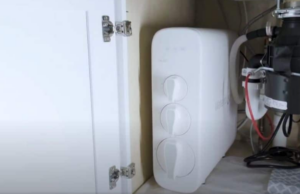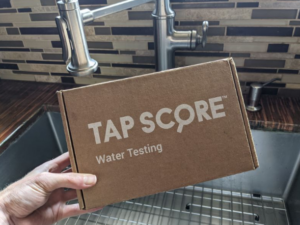Brown water is brought on by iron and manganese, rust, bad well construction, tannins, crumbled resin beads from water softeners, and silt.
Brown water is most usually a sign of excessive iron, rust, or other sediments in the water. There may be a number of causes for this. For instance, it can be that your pipes are rusted, the water supply has been temporarily suspended, or the water has a high mineral content.
According to testing, brown water often complies with safety requirements and is good for consumption. Yet, it appears incredibly unkempt and terribly unattractive, which discourages others from drinking it.
Fortunately, brown water seldom needs to be an issue. While it’s a typical issue with well water, there are several ways to get your water back to its original, cleaner form.
In this article, we’ve covered the typical reasons why the water in your well turns brown or discolored water as well as a long-term fix.
Causes of Brown Water
Iron & Manganese
Water that has been tainted by ferric iron or manganese from rains, snowmelt, or iron-bearing soil may appear dark brown, orange, or black. Browning of the water can also result from dissolved solids or dissolved iron entering the water supply due to corrosion of steel well casing or iron pipelines.
While being safe, iron and manganese are known to alter the flavor and odor of water.
Ferric iron stains are most likely to be seen when water and oxygen interact, oxidizing the iron.
Rust
Another reason why your water suddenly turns brown is rust in your water pipes. You probably have a rust problem in some of your plumbing if you find that you have brown iron water in certain areas of your house but not in others. Ferrous iron, often known as oxidized iron, is the culprit behind rusty water’s reddish-brown color.
Your hot water heater may possibly be rusted. You probably have a rusty heater if just the water coming out of your hot tap is brown.
Surface Water Seepage
If you have a shallow well hole and your water looks dark and smells musty or earthy, surface water leaking into your well is probably to blame. As surface water does not pass through layers of rocks and soil before entering your well, it is less clean than groundwater.
Surface water seepage is most likely to occur in areas with shallow groundwater levels. The minerals and organic matter in the water are what give the water its dark tint and musty smell.
Iron Bacteria
Iron bacteria are created when iron and oxygen interact. This kind of iron bacteria accumulates rust and bacterial cells, resulting in a slimy substance that adheres to the interiors of piping or plumbing fixtures.
If you see orange or reddish brown slime in your toilet bowl, iron bacteria is probably to blame. Beware of those iron bacteria.
Poor or Failing Well Structure

Your well’s construction might potentially be the reason why your water is coloured.
The side of the well house may eventually be touched by a detachable well water pump. The well pump may also be installed too low, which would allow silt to build up and give the water a hazy, brown look.
Tannins
By decomposing organic matter, such as peaty soil and leaves, tannins can enter your well water.
Water seeps through this organic matter during rainstorms and carries it into the well aquifer. Water is colored brown, yellow, or orange and has a bitter aftertaste as well as an earthy odor thanks to tannins. Although tannins are safe to consume, excessive quantities can be unpleasant.
Broken-Down Water Softener Resin Beads
Resin beads used in water softeners last for six to ten years.
If you’ve had your water softener for a while and discover that your water has a black or brown tint, it’s possible that broken-down resin beads have leaked into your water and are to blame. By changing the resin bed, you can resolve this problem.
Silt & Sediment
All well water aquifers include silt and sediment. Most of this sand shouldn’t be able to enter your water, though. Nevertheless, if your well screen is faulty or worn out, silt might cause your water to abruptly turn brown. Water that is dark, murky, or unclean is the result of silt and sediment.
Although silt in and of itself is not a problem, it may be a sign that other, more dangerous pollutants, such as E. Coli bacteria, can enter your well.
How to Get Rid of Brown Water?
Sediment Filtration
The best solution for silt or sediment-related brown water is to install a sediment filter. A full home well water filtration system can be fitted with sediment filters as pre-filters or independent filters.
Physical filtration is used by sediment filters to capture pollutants in their medium. To increase the longevity of some sediment filters, they can be manually flushed. Filters with pore diameters ranging from 1 to 50 microns (or more) may remove particles of various sizes.
You may also fix this problem by replacing your resin bed.
Air Injection Oxidization
The best way to treat iron and manganese-related brown water is using air injection oxidation. An air bubble in a pressure tank is used in an air injection oxidation system to oxygenate these pollutants before filtering the water supply with a brim or manganese greens and medium.
Iron concentration may be significantly reduced by most air injection filters. Certain systems are capable of removing up to 15 PPM (parts per million) of iron and 5–10 PPM of manganese from the water supply.
Reverse Osmosis System

The most complete at-home water treatment for eliminating all dissolved solids, including those that give water a reddish-brown hue, is a reverse osmosis device. More than 99.99% of the total dissolved solids are removed by RO systems, which filter water using several different media and a semi-permeable membrane.
The majority of RO systems are installed as under-sink appliances that supply filtered water from your cold water taps. Less frequently found are intricate whole-home reverse osmosis systems that are installed before your hot water heater.
Low quantities of iron, tannins, and sediment can be eliminated by reverse osmosis. Water with a high sediment or iron concentration, which might clog the RO membrane, has to be pre-treated, though.
Greensand Filtration
To get rid of brown or rusty water impurities, greensand filter media doesn’t necessarily need to be paired with an air pocket.
When applied alone, the manganese oxide coating on greensand medium oxidizes the iron and manganese in well water, converting them into particles that may be removed during system backwashing.
Water Softener System
The greatest approach to enhance water quality by eliminating minerals and iron from well water is using a water softening system. Before the water enters your hot water heater, softeners are placed at the main water line of your house. Almost all hard water problems may be handled by these systems, as well as iron levels of 5 PPM.
Ion exchange, sometimes referred to as water softening, is the process of exchanging calcium, magnesium, and iron ions for sodium ions. This softens the water and stops it from rusting or becoming limescale.
Well Repairs
You must fix your well if malfunctioning well parts are causing your water to become brown.
To stop sediment and silt from plugging up your well, for instance, you’ll need to repair the old well screen. You’ll need to make arrangements to have the well pump elevated if it is too close to the well’s bottom in order to lower the amount of sand and silt in your water.
Pipe Replacement
Last but not least, replacing your water pipes can be the finest option if rusty pipes are the root of your water discoloration.
The long-term expense of repairing your pipes is frequently less than installing an iron filter to address the problems of rusty pipes. Ask for quotations from a few different local plumbers to determine how much it will cost to replace your pipes.
How to Choose the Right Water Treatment System to Fix Brown Water
The methods below might help you pick the finest water treatment system to cure brown drinking water.
Step 1: Get Your Water Tested

Even if you might be able to identify the reason why your well water is brown, it’s still advisable to perform a thorough water test to find out exactly what’s in it.
Purchasing a lab test package is the option that offers the most extensive testing. Several of the most frequent well water toxins may be tested for in laboratories, providing you a comprehensive understanding of the reasons why your water is brown.
After you are aware of the toxins in your water, you may focus on water treatment methods that can get rid of brown water. Depending on their potential for causing health problems or cosmetic harm, you can also order the pollutants to be eliminated.
Step 2: Determine Your Budget
Decide how much you are willing to spend on a water system for your brown well water next. A typical whole-house treatment system costs between $900 and $2,500. Depending on their capabilities and maintenance needs, some systems cost more than this.
The annual ongoing expenditure for many water systems is in addition to the initial expense. You may need to replace the filters or media, or pay for increased water use for backwashing or energy for system programming. An yearly investment in a well water system is between $50 and $250.
Step 3: Size Your System
When you’ve narrowed down your options for treatment systems based on their effectiveness and your budget, pick the system that is the proper size for your house.
For various water usage, some systems exist in a variety of sizes. In order to avoid problems with decreasing flow rate or water pressure, select the system size that is best for the number of bathrooms in your home.
FAQs
What does brown tap water mean?
Iron, manganese, sediment accumulation, tannins, or rusty pipes are the typical causes of brown tap water. Testing a water sample will allow you to pinpoint the precise reason why the water is brown.
Is it safe to drink brown water?
Drinking brown water is generally safe. But if you find that your water has suddenly turned brown, it’s wise to test it. The likelihood is that your water only includes iron or tannins, but you should also rule out any potentially harmful chemicals that may have gotten into your well water along with the impurities that cause browning.
Why is my water brown when I first turn on the tap?
You probably have rusty piping or rust in your hot water heater if your water first appears brown when you switch on the hot and cold faucets but soon becomes clear.
Why is my well water suddenly dirty?
If your well screen wears out or breaks, letting heavy sediment into your well, your well water can suddenly become foul. This will make the water seem murky, muddy, and tainted with brown.
Is it safe to use brown water?
Yes, it is okay to use brown water. But, some impurities that cause water to appear brown, such iron, might harm the plumbing in your house. It is thus safe to use water that is brown, orange, or yellow, but the impurities in your water may leave stains and cause corrosion in your pipes.
Is brown water an emergency?
Although it depends on which chemicals have turned your water dark, brown water is seldom a serious problem. Brown water is typically brought on by iron and manganese. To be sure nothing harmful has gotten into your well, it’s important to do a water test if you find your water has suddenly turned brown.
Can brown well water make you sick?
No, drinking brown well water is seldom unhealthy. Brown water is likely to taste metallic, earthy, or unpleasant and may leave rust stains in your plumbing and well system.
Why is the water in my toilet brown?
Iron or iron bacteria are most likely to blame for the brown water in your toilet tank or bowl. As iron is oxidized by air, it causes rust streaks on surfaces, whereas iron bacteria forms a thick, slimy, orangey-brown sludge that frequently accumulates in stagnant water.